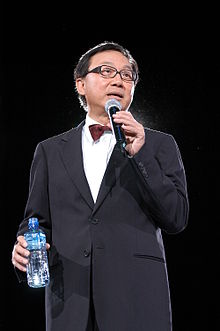|
Chinese New Year film
A Chinese New Year film (simplified Chinese: 贺岁片; traditional Chinese: 賀歲片, Mandarin: hèsuìpiān, Cantonese: ho6seoi3pin3) refers to movies usually released during the Chinese New Year period. It is a film that varies in genre (fantasy, comedy, action, animation, and the like) but whose style is generally relaxed and humorous.[1] It sometimes focused around the horoscope animal, theme, and other attributes for the upcoming year, taking these Chinese New Year ideas and presenting them in a modern and exciting way. A recent tradition, it has become a popular way to celebrate Chinese New Year.[2] IntroductionFolklorists believe "New Year's Movie Culture," or the first Chinese New Year films, can be traced back to the operatic players in the late Qing dynasty. During the Chinese New Year holidays, the stage boss gathered the most popular actors from various troupes and lete them perform repertories.[3] Early history The Chinese New Year films were first made in Hong Kong.[4] Although the tradition is only about 30 years old, it has become a classic and now provides Hong Kongers with a sense of continuity and belonging. Film studios promote their new movies, with plans to roll out more advertising in mainland China in the coming year.[5] The common themes of these films are the realities, the festivities, and the customs associated with the season.[6] In 1937 the first Chinese New Year film premiered in Hong Kong;[7] the movie, titled Bloom and Prosper (花開富貴), broke all box office records. Because of the film's success, more followed in the 1950s and '60s, such as Marriage Between Poorness and Richness (萬事勝意) in 1963, Fortune (招財進寶) in 1960, Happiness at the Door (喜臨門) in 1958, Home Sweet Home (歡喜夫妻) in 1961, and May Luck be with You (一帆風順) in 1965.[8][9] In the 1970s the Kung Fu genre reached its height, coinciding with Hong Kong's economic boom. The film The 36th Chamber of Shaolin, received universal acclaim and is widely considered to be one of the greatest Kung fu films made until then; it is a highly influential film of the genre.[10][11][12][13] Because of such success, kung fu films have become an important product of Hong Kong cinema.[14] Even Jackie Chan, a famous actor known for his martial art movies, has the habit of watching a Chinese New Year film every year.[15] Security Unlimited, a 1981 comedy directed by the Hui Brothers, is now considered the first modern Chinese New Year film in Hong Kong.[16] The next year, Mad Mission ushered in a new epoch in movie star history; it is now recognized by audiences in other countries and regarded as one of the most successful movies among the Hui Brothers' comedies.[17] From the 1980s and the 1990s the city's economic boom helped create its flourishing film industry. Movies made during this time include the "Aces Go Places" series, the "Winners and Sinners" series, "All's Well, Ends Well" series, and others.[7] In 1995, the Hong Kong film Rumble in the Bronx was introduced to mainland China, marking the first time a movie was promoted and distributed under the banner of a “New Year film” (hesuipian) there. In 1997, Feng Xiaogang’s The Dream Factory became the first New Year film from mainland China. Since then, Feng has been a staple of the genre and dominating the New Year film market in mainland China. Some of his iconic Chinese New Year films include Be There or Be Square, Big Shot’s Funeral, Cell Phone, and If You Are the One. After 2002, more Chinese directors, such as Zhang Yimou and Chen Kaige, entered the year-end film market. As the Chinese film industry grew rapidly in the new century, the New Year film season gained increased attention, becoming one of the most productive periods in China’s film calendar. The genre also evolved from primarily comedic New Year films to a more diverse range of offerings. List of Chinese New Year filmsChina mainland
Hong Kong
TaiwanMalaysia
References
|